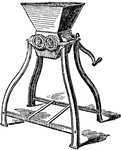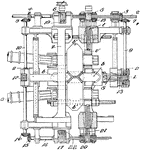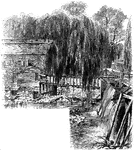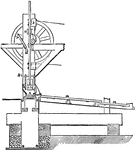Clipart tagged: ‘mill’

Band Resaw
A resaw is a large band saw optimized for cutting timber along the grain to reduce larger sections into…

Blake Ore Breaker
This illustration shows a Blake Ore Breaker (stone crusher), used in a gold stamp mill. This crusher…

Howard's Bridge and Mill
"Advance of the Federal troops, near Howard's Bridge and Mill, four miles from Big Bethel, on the road…

Cane-apron
"The apron is supported and carried by flanged wheels, fixed at distances apart upon shafts, one of…

Centrifugal Mill
"The upright cyclinder a, is a tube which has a funnel shaped mouth for the admission of the stream…
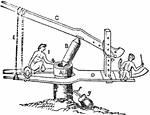
Chinapatam Sugar-mill
"The Chinapatam Sugar-mill consists of a mortar made by cutting down some hard-wood tree to within 2…
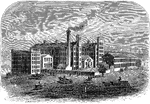
Cotton Mill
An illustration of a cotton mill in Columbus, Georgia. A cotton mill is a factory housing spinning and…
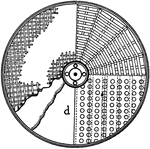
Cyanide Leaching Tank (Gold Extraction)
In the gold extraction process, finely crushed ores are leached in vats with a very diluted solution…

Pulp Engine
A machine used for converting paper rags, esparto, and other materials into pulp with water.

Frue Vanner (Side View)
A Frue Vanner is a shaking, rubber belt used to concentrate gold ore 'pulp'.

Scene of the Battle of Gaines' Mill
Mill, with a man standing and a man on horseback in the foreground.
Gunpowder Mill
"A sectional elevation of incorporating mill, showing one runner and ploughs (p, p); C, curb of bed;…

Gunpowder Mill
"A sectional elevation of incorporating mill, showing one runner and ploughs (p, p); C, curb of bed;…

Gunpowder Mill
"Breaking-down Machine. H, hopper; B, endless band; R, rollers; M, boxes to receive meal." — Encyclopedia…
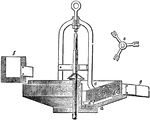
Hungarian Mill
"This consists of a cast-iron pan a, having a shallow cylindrical bottom b, holding 50 lb of mercury,…

Drawing Process in the Manufacturing of Jute
After the carding process in the manufacturing of jute is completed, the jute is taken into the drawing…

Spinning Process in the Manufacturing of Jute
In the last step of the manufacturing process of the jute plant, the material is taken on bobbins to…
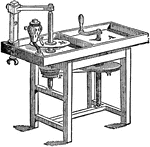
Lapidary's Mill
"In the ordinary pattern of a lapidary's bench the handle turns in a horizontal plane, where W is the…

Lapidary's Mill
"Part of Lapidary's Mill. A, upper summer (cut through); B, lower summer (cut through); C, spindle;…
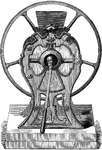
Mill
This mill was manufactured in Birmingham, England. It was possibly used as a textile mill for processing…
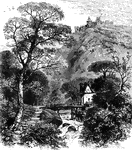
Mill on a Mountain Stream
A small mill sits on a briskly-flowing mountain stream. A footbridge crosses the stream. A larger building…

Barker's Mill
"Grain enters the mill at H down into D and into tube A. The grain passes down through the holes B and…
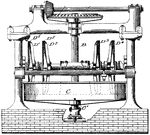
Bed Pan Grinding Mill
A grinding mill is a unit operation designed to break a solid material into smaller pieces. The grinding…

Cider Mill
Machining process used to create cider, allowing for different types of apples to be mixed for juicing.

Floating Flour Mill
A mill which grounds grain into flour. This flour mill is located on a body of water.

Grinding Mill
A grinding mill is a unit operation designed to break a solid material into smaller pieces. There are…

John Mill
Author and statesman, born in London, England, May 20, 1806 died in Avignon France, May 9, 1873.

Vertical Cane Mill
"The accompanying engraving is an illustration of a new style vertical mill in which an attempt is made…

Vertical Cane Mill
"To avoid the inconvenience of having the team travel around the mill, interfering with the passing…

Ring Milling
"The workpiece is fastened on a round platen, which in turn is attached to the table of a large and…
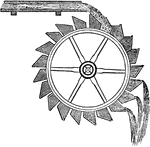
Overshot Wheel
"This wheel of all others, gives the greatest power with the least quantity of water, and is, therefore,…

Parting Vessel
"The parting vessels are of porcelain which, to protect them against fracture by irregular heating,…
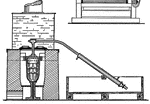
Retort Furnace for Gold Bullion
This furnace is used to purify a gold concentrate. The gold concentrates, if non-pyritic, are treated…
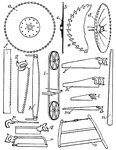
Collection of Saws
This illustration includes numerous types of saws: a. Circular saw (right-hand and left-hand saws have…

A Sugarcane Mill
In a sugarcane mill, sugarcane is washed, chopped, and shredded by revolving knives.




